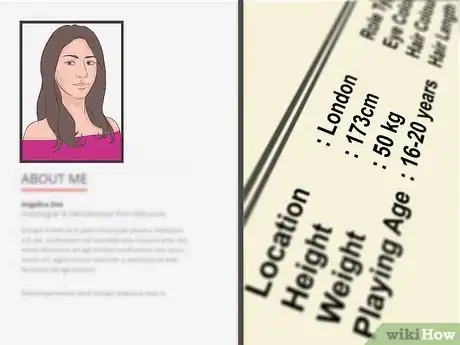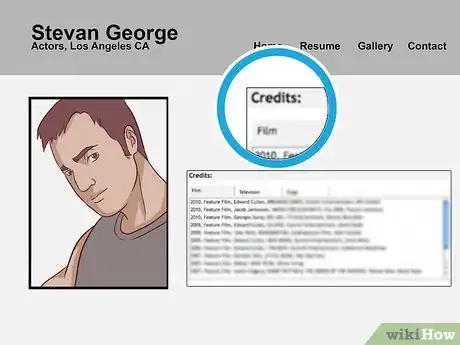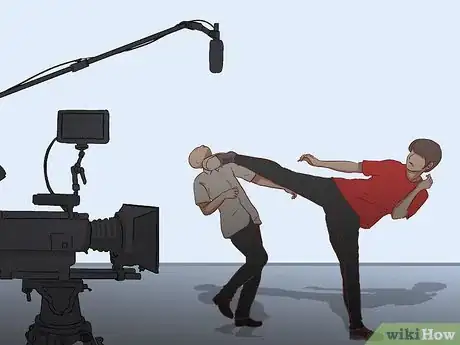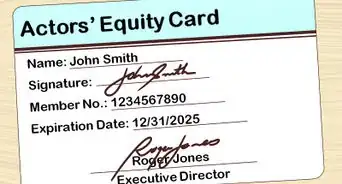This article was co-authored by Lesly Kahn, MFA. Lesly Kahn is an acting teacher and coach based in Los Angeles, California. She is the founder and owner of Lesly Kahn & Company, Actor Training, which focuses on preparing actors for employment in film, television and theatre. With well over 30 years of experience, Ms. Kahn has coached hundreds of actors who have become household names. She also ran the BFA Program in Acting at Marymount Manhattan College, and worked in television as well as New York and regional theatre. Lesly holds a BFA from New York University and an MFA from The Yale School of Drama.
There are 8 references cited in this article, which can be found at the bottom of the page.
wikiHow marks an article as reader-approved once it receives enough positive feedback. In this case, 89% of readers who voted found the article helpful, earning it our reader-approved status.
This article has been viewed 164,870 times.
If you'd like to work professionally as an actor, you'll need to make a portfolio. This portfolio functions as a document that you can distribute to casting director at or before auditions. A high-quality acting portfolio makes you appear professional and hirable, and should emphasize your acting experience and talents. You'll need to include a professional headshot, an acting resume, and a demo reel that shows the strengths and variety of your acting ability.[1]
Steps
Making an Acting Resume
-
1Include physical information relevant to acting. Unlike most other careers, casting directors need to know your physical size and appearance. At the top of your resume, list your name and contact information. Beneath this, specify your height, weight, hair color, and eye color.[2]
- An acting resume is similar to any other type of professional resume: it should open with your name, include an acting union affiliation (if applicable), and contact information.
- Unless you are under 18 years old, do not list your age.
-
2Highlight your acting credits. This information can be placed in a “Credits” section. If you have acted before and have some theater, TV, or film credentials, be sure to list this information on your resume. Tailor your resume towards the specific role that you're planning to audition for. Highlight acting roles that are similar to this role.[3]
- That means that, if you are audition for a comedic role and have acted in comedy before, these roles should be at the top of your “Credits” section.
- Easy ways to gain experience and build relationships include acting in student films and independent films. The important thing is that you gain tape of yourself, which is important for sharing your work.[4]
Advertisement -
3Create an Education section. Include your acting-related training and education. If you attended a well-known acting school, studied with a famous acting coach (or actor), or majored in acting, theater, or drama, include this information on your resume.[5]
- If you have been professionally trained as an actor outside of an academic setting, use your resume to highlight the training you received and its duration.
-
4Focus on your relevant previous experience. You can present this information in a “Work Experience” section. Instead of filling your resume with every role you've ever played, tailor your presentation of work experience. Include professional work you've done (after high school and college) that is relevant to the role you're auditioning for.[6]
- For example, if you're auditioning for a role in an action movie, use your resume to highlight other action-oriented roles you've played in the past.
- Just like on any other type of resume, you won't impress anyone by having a resume full of irrelevant details.
Choosing Headshots
-
1Reach out to a professional headshot photographer. Headshots are a crucial part of an acting portfolio, and they should be taken professionally.[7] Headshots, as the name suggests, are photographs that only show your face and neck. Search online or reach out to other friends in acting to find a local photographer who can take high-quality headshots for your acing portfolio.[8]
- Never try to take your own headshots. Even if the photographs look acceptable to you, a casting director or audition manager will be able to tell that they are not professional-grade material.
-
2Choose the two headshots that you like best. You'll have many options to choose from following your headshot photoshoot. A good acting portfolio should include two (or three) headshots, so choose a couple of photos that look good and that you'd be proud to hand to an audition manager.[9]
-
3Vary your facial expressions in your headshots. It would be redundant to present headshots with two identical expressions. For example, in one headshot you could have a more “edgy” look, while in a second shot you could have a broad, welcoming smile.[10]
-
4Choose headshots that are tailored to your role. Since you'll be relying on your headshot to appeal to casting directors and land you auditions, make sure that your headshot suits the type of role that you're auditioning for. Headshots can convey the “type” of actor that you are, and the type of character that you're capable of portraying.[11]
- For example, don't submit a headshot in which you look edgy and rebellious if you're audition to play a lovable, kind character.
-
5Tailor your headshot to the type of acting you're doing. Headshot demands can differ based on the type of acting work you're auditioning for. If you're planning to work in television or to appear in commercials, you'll need what's known as a “commercial” headshot, in which you are smiling. If you want to audition for theater or films, plan to submit a more serious headshot in your acting portfolio.[12]
Putting Together a Demo Reel
-
1Contact a professional reel producer. Your demo reel (sometimes called a showreel) should give casting directors an idea of your acting ability and versatility. A professional demo-reel editor will be able to take the various sequences of footage that you provide, and edit the scenes together into an effective demo reel.[13]
- Be prepared to pay for this service. Demo-reel editors usually charge from $60 to $75 an hour.[14]
-
2Select from footage of your highest-profile acting work. Demo reels typically contain footage shot in a theater, or clips of the actor's performance on film or television. However, if you're an inexperienced actor and have not had any significant acting performances, it's acceptable to make a demo reel using independent films, student films, or online media.[15]
- If necessary, you can even film yourself acting to make your own demo reel. Make sure to stand in front of a blank background, and shoot close in. Only your chest, arms, and face should be visible in the footage.[16]
- Reels simply help demonstrate that when you have a camera in your face, you don't freak out.[17]
-
3Include 60-90 seconds of your best work. Select three or four scenes that are relatively similar to the role you're auditioning for. This will show the audition manager you're capable of performing the type of role that the script calls for. Don't make the demo reel much longer than 90 seconds.[18]
- Even as little as 60 seconds will give the casting director enough material to make a decision.
Expert Q&A
Did you know you can get expert answers for this article?
Unlock expert answers by supporting wikiHow
-
QuestionWhat should I do if I don't have a lot of acting experience to put on my resume?
 Lesly Kahn, MFALesly Kahn is an acting teacher and coach based in Los Angeles, California. She is the founder and owner of Lesly Kahn & Company, Actor Training, which focuses on preparing actors for employment in film, television and theatre. With well over 30 years of experience, Ms. Kahn has coached hundreds of actors who have become household names. She also ran the BFA Program in Acting at Marymount Manhattan College, and worked in television as well as New York and regional theatre. Lesly holds a BFA from New York University and an MFA from The Yale School of Drama.
Lesly Kahn, MFALesly Kahn is an acting teacher and coach based in Los Angeles, California. She is the founder and owner of Lesly Kahn & Company, Actor Training, which focuses on preparing actors for employment in film, television and theatre. With well over 30 years of experience, Ms. Kahn has coached hundreds of actors who have become household names. She also ran the BFA Program in Acting at Marymount Manhattan College, and worked in television as well as New York and regional theatre. Lesly holds a BFA from New York University and an MFA from The Yale School of Drama.
Acting Teacher & Coach You can make any resume more interesting and make it stand out from the crowd by being creative, but I am not a big fan of lying. You should be very truthful. Only include what you've actually done, and find other ways to make your resume stand out, like being funny on it. You should also do more theater and study with really good people so you can build up your resume.
You can make any resume more interesting and make it stand out from the crowd by being creative, but I am not a big fan of lying. You should be very truthful. Only include what you've actually done, and find other ways to make your resume stand out, like being funny on it. You should also do more theater and study with really good people so you can build up your resume. -
QuestionIs a portfolio required for acting?
 Jim JarrettJim Jarrett is an Acting Teacher and the Founder of The Meisner Technique Studio based in San Francisco, California. With over 30 years of experience, he specializes in teaching The Meisner Technique and is Sanford Meisner's last teaching protégé. Over the years, Jim has established schools in Los Angeles, California, Hawaii, and Sun Valley, Idaho. He also travels the world annually as a guest teacher at universities, performing art schools, and theater companies throughout North America, Europe, and Asia. His flagship school is located in the heart of the Presidio in San Francisco, California.
Jim JarrettJim Jarrett is an Acting Teacher and the Founder of The Meisner Technique Studio based in San Francisco, California. With over 30 years of experience, he specializes in teaching The Meisner Technique and is Sanford Meisner's last teaching protégé. Over the years, Jim has established schools in Los Angeles, California, Hawaii, and Sun Valley, Idaho. He also travels the world annually as a guest teacher at universities, performing art schools, and theater companies throughout North America, Europe, and Asia. His flagship school is located in the heart of the Presidio in San Francisco, California.
Acting Teacher
-
QuestionHow can I become a good actor
 Community AnswerTry to understand the words in the script. If there is a word or phrase that you do not understand, don't be afraid to look it up. Put yourself in the character's shoes. Use hand movement and body language.
Community AnswerTry to understand the words in the script. If there is a word or phrase that you do not understand, don't be afraid to look it up. Put yourself in the character's shoes. Use hand movement and body language.
References
- ↑ https://auditions.com/blog/industry-advice/how-to-make-an-impressive-portfolio-for-acting-auditions/
- ↑ http://www.dailyactor.com/acting-resume/
- ↑ http://www.ace-your-audition.com/actor-resume.html
- ↑ Jim Jarrett. Acting Teacher. Expert Interview. 28 April 2020.
- ↑ http://www.ace-your-audition.com/actor-resume.html
- ↑ http://www.dailyactor.com/acting-resume/
- ↑ Jim Jarrett. Acting Teacher. Expert Interview. 28 April 2020.
- ↑ https://www.backstage.com/advice-for-actors/backstage-experts/7-tips-better-headshot/
- ↑ http://personalfinance.costhelper.com/acting-portfolio.html
- ↑ http://personalfinance.costhelper.com/acting-portfolio.html
- ↑ https://www.backstage.com/advice-for-actors/backstage-experts/7-tips-better-headshot/
- ↑ http://personalfinance.costhelper.com/acting-portfolio.html
- ↑ https://www.nyfa.edu/student-resources/how-to-make-an-actor-demo-reel/
- ↑ http://personalfinance.costhelper.com/acting-portfolio.html
- ↑ https://www.nyfa.edu/student-resources/how-to-make-an-actor-demo-reel/
- ↑ https://www.backstage.com/magazine/article/make-demo-reels-6179/
- ↑ Jim Jarrett. Acting Teacher. Expert Interview. 28 April 2020.
- ↑ http://personalfinance.costhelper.com/acting-portfolio.html
- ↑ http://www.dailyactor.com/acting-resume/
- ↑ http://personalfinance.costhelper.com/acting-portfolio.html
About This Article
To create an acting portfolio, start by writing your acting resume, which should give your height, weight, age, and hair color. You should also include details of any professional acting credits, acting-related education, and any relevant experience you have. Make sure to get professional headshots taken, which will help your portfolio stand out. Use the 2 best shots which capture expressions related to roles you’d like to play. Once you’ve added your headshots to your resume, hire a demo reel editor, or edit it yourself. Use 3 or 4 scenes from previous roles in TV, theater, or independent films to show off your acting talents. If you have no footage at all, film yourself acting in front of a screen to showcase your abilities. For more tips, including how to tailor your headshots to the movie genre you want to play, read on!











































































